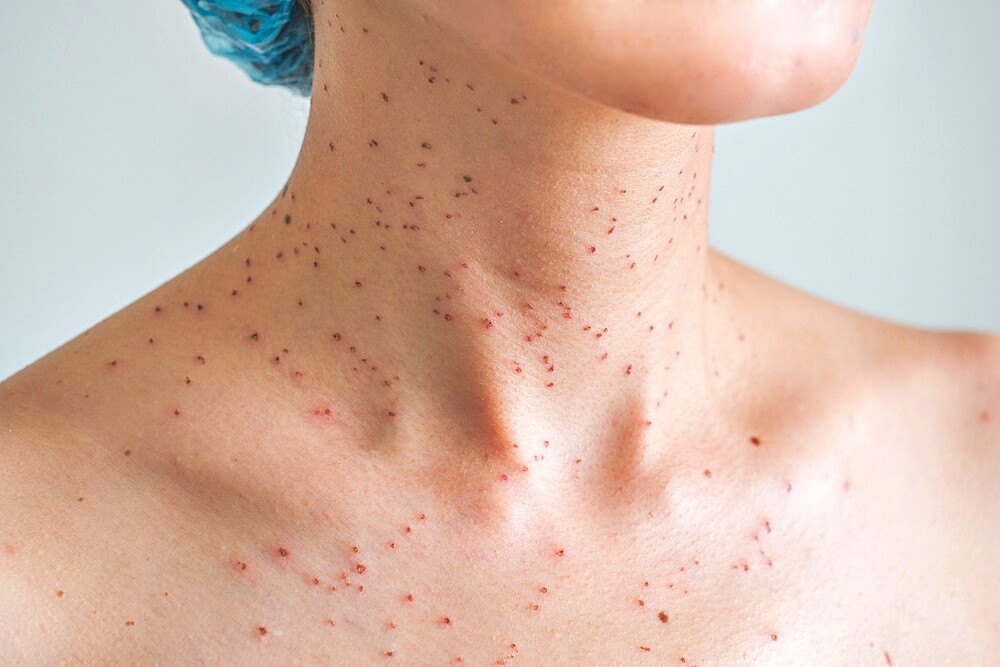Red spots on the skin can have various causes. You can find out here which possible causes there are and what you can do.
Where do red spots on the skin come from and are they dangerous? What might be behind the dots, we’ll tell you here.
Red spots on the skin
Red spots on the skin can be disturbing, especially if they appear on the face. However, what is behind the red dots cannot be generalized. The (increased) occurrence on certain parts of the body, the colouring, etc. indicate different causes. The following causes can have red spots on the skin, among others.
Possible causes
1. Hemangiomas
Hemangiomas rarely occur in adults, and often infants and toddlers are affected. Hemangiomas are benign neoplasms of the blood vessels, which usually regress on their own.
What to do?
Your doctor can best determine if these are hemangiomas. If so, they are usually harmless and are not accompanied by pain or other troublesome symptoms. However, they could be sclerosed with a laser for aesthetic reasons.
2. Leukocytoclastic vasculitis
Behind this bulky name is an inflammation of the blood vessels. This is noticeable by small intense red spots on the lower legs, the colour of which can change from red to blue-red within a few days. Itching or burning may also occur. In addition, these spots can develop into bleeding dark red nodules.
What to do?
Leucocytoclastic vasculitis can be triggered by a hypersensitivity reaction to, for example, a drug. If you notice such spots on your legs you should consult a doctor. After a confirmed diagnosis, the right therapy can be chosen here.
3. Herpes zoster
Shingles is a viral disease, the pathogen can also cause other diseases (e.g. chickenpox). Herpes zoster causes a skin rash with small blisters that can be painful. Other symptoms are headache and aching limbs, slight fever and a general feeling of illness.
What to do?
If you suspect shingles, see a doctor. Light painkillers can help against the pain. Shingles is contagious until the rash or blisters have completely healed.
4. Couperose/rosacea
Rosacea is a skin disease in which dilated veins (so-called telangiectasia) appear on the face. These dilations of tiny blood vessels visible to the naked eye often occur on the cheeks and around the nose. In its early stages it is called couperosis.
What to do?
Couperosis or rosacea is probably hereditary and often there are personal triggers that can aggravate the redness. You can find more information and care tips in the articles about couperose and rosacea.
5. Miliaria
Miliaria, or heat rash, is manifested by itchy blisters. These heat spots are caused by increased sweating, but evaporation of sweat is prevented, e.g. by tight clothing. Due to the backlog in the ducts of the sweat glands, they become blocked and heat spots develop.
What to do?
Make sure you wear suitable clothing when it’s hot, such as cotton and linen, and stay in cooler places. You can find out what else helps here: What to do about heat spots.
6. Keratosis pilaris
This disease, also called grating iron skin, is a cornification disorder. This means that the body produces too much keratin, causing the hair follicles to clog. As a result, small plugs are formed, which are visible on the skin surface through white and red pimples. They often appear on the thigh and upper arm, but other areas such as the face or bottom can also be affected.
What to do?
The red spots should go away on their own. What you shouldn’t do is squeeze the spots! You can help with moisturising and horny creams (e.g. with urea) and peelings.
7. Allergy
An allergy can also be the cause of a rash. In a so-called contact allergy, your skin reacts allergically to something you have come into contact with. This could be fragrances or metals (such as nickel). Besides red spots, itching can also occur. However, the allergic reaction only occurs after 24 to 72 hours.
What to do?
A patch test can be done at the dermatologist’s office. This will help you to find out if you have any allergies, and if so, to what. This substance should then be avoided.

